March 11, 2016
Air Date: March 11, 2016
FULL SHOW
SEGMENTS
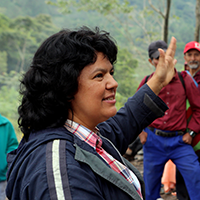
Honduran Environmental Activist Murdered
View the page for this story
Berta Cáceres, an indigenous activist who opposed huge dam projects in her native Honduras, was recently murdered in her home. This draws attention to dangers that environmental activists in her country face. Billy Kyte of the British NGO global witness tells host Steve Curwood that she was one of the bravest people he’d ever met and that Honduras is among the most dangerous countries in the world for environmental campaigners. (09:50)
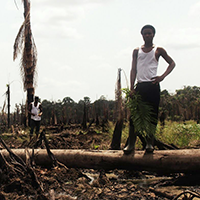
Shell Sued In UK Over Nigerian Pollution
View the page for this story
Countless oil spills over decades have destroyed fishing and farmland and turned the once beautiful Niger Delta into a toxic wasteland. Lawyer Daniel Leader is suing Shell Oil in UK courts on behalf of local Nigerian communities, in an effort to clean up the ecosystems where they live. Daniel Leader discusses the lawsuit with host Steve Curwood. (08:20)

Sanders and Clinton on Flint Crisis and Fracking
View the page for this story
The seventh Democratic debate of the election year refocused the spotlight on Flint’s lead crisis, with both candidates calling for Michigan Governor Rick Snyder’s resignation. Secretary Clinton expressed opposition to fracking, with some reservations, while Senator Sanders flatly rejected it and reiterated the urgency of acting on climate change. (03:35)

Rising Seas and Real Estate Prices in Fort Lauderdale
View the page for this story
The south Florida community of Fort Lauderdale lies mostly just two above sea level, and already floods multiple times a year. Yet it’s currently undergoing a home construction boom, and real estate prices are rising. Host Steve Curwood and reporter Katherine Bagley discuss the social consequences of this paradox. (07:50)
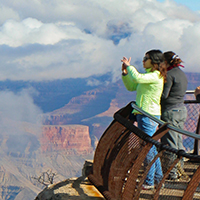
Beyond the Headlines
/ Peter DykstraView the page for this story
In this week’s trip beyond the headlines, Peter Dykstra tells host Steve Curwood about Gov. Chris Christie’s opposition to funding lead poisoning prevention, and a battle against development and support for uranium mining near the Grand Canyon. They also look back at a flap over cyanide-laced Chilean grapes and note the loss of a master of environmental photography, Gary Braasch. (04:30)

Emerging Science Note/Carbon-Cleaning Icebergs
/ Jaime KaiserView the page for this story
Living On Earth’s Jaime Kaiser reports on a new study about Antarctic Icebergs, which suggests that as they melt they release nutrients that cause algal blooms that then sequester carbon from the atmosphere in the deep ocean when they die. (02:00)
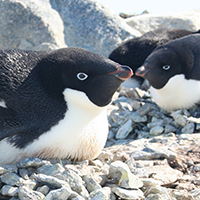
Penguin Colony Uprooted by Ice in a Warming World
View the page for this story
Researchers who study Adelie penguins in Antarctica returned to their study site to find most of the birds gone. This follows a massive iceberg blocking the colony from their feeding grounds. Penguin researcher Kerry-Jayne Wilson tells host Steve Curwood what she believes happened to the missing penguins and how climate change could be spawning more icebergs in the southern ocean. (07:00)
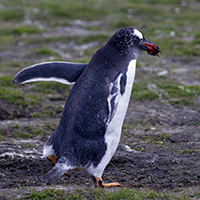
Stealing Dirt: A Thieving Penguin
/ Mark Seth LenderView the page for this story
Visiting the Falkland Islands, writer Mark Seth Lender watched Gentoo penguins building nests from mud, the only material available. But one male wanted stickier dirt from a neighboring colony whose members objected. Still, his mate appreciated the mud and him. (03:30)
Show Credits and Funders
Show Transcript
HOST: Steve Curwood
GUESTS: Billy Kyte, Danile Leader, Katherine Bagley, Kerry-Jayne Wilson
REPORTER: Jaime Kaiser, Peter Dykstra, Mark Seth Lender
[THEME]
CURWOOD: From Public Radio International, this is Living on Earth.
[THEME]
CURWOOD: I'm Steve Curwood. Remembering Berta Cáceres, an environmental campaigner in Honduras, killed for opposing a massive dam project.
KYTE: She was incredibly brave, probably the most fearless person I’ve ever met, despite all the threats against her life, and despite seeing colleagues of hers being killed, she never strayed from her struggle, her cause, which is the simple exercise of rights for her community.
CURWOOD: Why Honduras is so dangerous. Also, a disappearing act...what happened to a colony of Adelie penguins?
WILSON: Adelies are very aggressive normally, and very active penguins. Normally they will hit you with their flippers, try biting you, and these are usually very noisy, and the colony was silent.
CURWOOD: How global warming is playing out in Antarctica. That and more this week, on Living on Earth. Stick around.
[NEWSBREAK MUSIC: Boards Of Canada “Zoetrope” from “In A Beautiful Place Out In The Country” (Warp Records 2000)]
ANNOUNCER: Support for Living on Earth comes from United Technologies – innovating to make the world a better, more sustainable, place to live.
Honduran Environmental Activist Murdered

Indigenous Honduran activist Berta Cáceres (Photo: Goldman Prize)
CURWOOD: From the Jennifer and Ted Stanley studios at the University of Massachusetts Boston and PRI, this is Living on Earth. I’m Steve Curwood. On March 3rd, Honduran environmental activist Berta Cáceres was shot dead in her home by gunmen. Local police claimed at one point it was a robbery gone wrong, but many human rights and environmental campaigners are calling it an assassination. Berta won the prestigious Goldman Environmental Prize in 2015 for her work as part of a movement that opposed the Agua Zarca Dam projects on the Gualcarque River, which would have cut off her Lenca people from water and food. In her acceptance speech for the Goldman Award she spoke of the importance of indigenous peoples to environmental protection.
[APPLAUSE]
CÁCERES: Gracias, Buenos noches.
TRANSLATION: In our worldview we are beings who come from the Earth, from the water, and the corn. The Lenca people are ancestral guardians of the rivers, in turn protected by the spirits of young girls, who teach us that giving our lives in various ways for the protection of the rivers is giving our lives for the well being of humanity and of this planet.
The Gualcarque River has called upon us, as have other gravely threatened rivers. We must answer their call. Our mother Earth, has been militarized, fenced-in, and poisoned — it’s a place where basic rights are systematically violated—demands that we take action. Let us build societies that co-exist in a just and dignified way that protects life.
CURWOOD: She concluded her speech with a call to action.
CÁCERES(IN SPANISH) I dedicate this award to all the rebels out there, to my mother, to the Lenca people, to the Rio Blanco, and to the martyrs who gave their lives in the struggle to defend our natural resources. Thank you very much.

Berta Cáceres with her Lenca people (Photo: Goldman Prize)
[APPLAUSE]
CURWOOD: Berta Cáceres’ murder has been met with protests worldwide at the Honduran government’s failure to protect her. But sadly, the killing of environmental activists like Berta is rampant. The UK environmental organization Global Witness reported that Honduras is the most dangerous place in the world to fight for the environment. We’re joined now by Billy Kyte from Global Witness, who knew Berta Cáceres.
KYTE: She was incredibly brave, probably the most fearless person that I've ever met. I first met in incongruous surroundings of a disused petrol station in central Tegucigalpa, the capital of Honduras eating a burger. And despite all the threats against her life, the fact that some of her family were living in exile in Argentina, despite seeing colleagues of hers being killed, she still never strayed from her struggle and her cause which is a simple exercise of rights for her community.
CURWOOD: Tell us a bit about what Berta Cáceres was fighting for?
KYTE: So, Berta represented the Lenca people, the indigenous group living in Honduras. The main cause that she was fighting for was against a huge dam project on her land, the way it was a water source for her community, the way of life for the Lenca people in the area. And over the years of campaigning against this dam project where all they were asking for was to be consulted on what would happen on their land, she received numerous threats, which ultimately ended her life.
CURWOOD: What kind of threats did she receive?
KYTE: She was constantly threatened by police in the local area, also by private security guards who were defending the dam project who were employed by Desa, the Honduran dam company. She also received threats via the Honduran state. They put spurious legal charges against her and her organization as well as not doing what they are required to by law, which is to give emergency protection. She had emergency protection from the Inter-American Human Rights Commission, but the numerous occasions that I spoke to her she said that this was not being properly implemented by the Honduran government.
CURWOOD: What relationship if any do you know there was between the Honduran government and the people who wanted to put up this dam?
KYTE: So we know that the Honduran government let it happen, even though under international law Honduras has signed an agreement, which supposedly guarantees the rights to indigenous people to make a decision on what happen on their lands - and this never happened.
CURWOOD: And how has the government responded to her death now?

Protesters demand justice for Berta Cáceres (Photo: Daniel López García, Flickr CC BY 2.0)
KYTE: At first, they tried to claim that it was a botched robbery. They've since come out and tried to also frame it as a crime of passion, but because of the huge international pressure on this case, they have relented and they've recently asked for the United Nations to support and accompany the investigation. I also understand that the US law enforcement agency’s closely supporting the investigation, and it's not an exaggeration to say that the world's eyes are watching Honduras right at this moment.
CURWOOD: Berta wasn't the first activist killed in Honduras. How dangerous is Honduras for environmental campaigners these days?
KYTE: So, from our research at Global Witness, Honduras is the most dangerous place per capita to be an environmentalist, 101 people were killed between 2010 and the end of 2014 just for defending their rights to the environment or their rights to land. One of the biggest conflicts of being over a palm oil plantation in northeastern Honduras which has led to 80 deaths of small scale farmers protesting, trying to get their land back from a large palm oil corporation. So we know that it's a mix between state’s and corporate interests behind a lot of these killings.
CURWOOD: How did Honduras get so dangerous for environmental activists?
KYTE: One of the main reasons is that in recent years the right wing government led by President Hernandez has sought investment in hydropower, mining, agribusiness and logging projects. Many of these projects go about without proper consultation of communities, of indigenous peoples, people are not being allowed to decide what happens on their land. Corruption is also a big driver behind a lot of these projects going ahead. There is another huge issue around impunity, the fact that people can get away with murder in Honduras.
CURWOOD: Billy, where else in the world are environmental activists seeing threats on their lives?

The Rio Blanco in Honduras, shot in 1988 (Photo: John Mikesell, Flickr CC BY SA 3.0)
KYTE: So, from our data from Global Witness, in 2014, three quarters of all killings of environmental activists took place in Latin America. Now, this could be because civil society movements in that area are relatively strong, so there's more monitoring of the problem and the issue and they're more likely to protest or campaign against what's happening there, but it's also because of the area being very resource rich with high levels of corruption and an unequal distribution of land. So, many marginalized communities such as indigenous people are being impacted. Apart from Latin America, Southeast Asia, particularly the Philippines, has always been hard hit by and crimes against environmental activists.
CURWOOD: What other countries in Latin America are especially dangerous for environmental campaigners?
KYTE: So Honduras is per capita the most dangerous place to be an environmentalist, but Brazil in absolute terms has the most victims, with 400 people killed over the last ten years or so in Brazil. Colombia is also an area where the mining sector has being a focal point for many protests and campaigning and has led to killings. And most recently in Peru last year, there have been big mining protests, which have caused killings of environmental activists in Peru.
CURWOOD: What needs to happen to protect environmental campaigners around the world?
KYTE: So firstly, people need to be held to account for these crimes. People are getting away with it and this must stop. Secondly, activists need to be protected. They need their governments to stop stigmatizing them, branding them as anti-development. Thirdly, we need to tackle the root causes. This means giving indigenous people the rights that are theirs under international law, ensuring that there is less corruption and more transparency in how a lot of these projects are given, and lastly we need to be monitoring the issue a lot better and raising it an international fora.
CURWOOD: Billy, there is a long list of people who have died protecting their environment: Chico Mendez in the Amazon, Ken Saro-Wiwa in Nigeria. Any hope that Berta's death could be a turning point here?
KYTE: Well, I think we've seen from the international outcry, this has really struck a chord within the international community. I just hope that something good comes from the tragic events. This needs to be a rallying call to really ensure that these activists who are at the front line of battle to save the environment should not be attacked and killed, but should be seen as heroes.
CURWOOD: Billy Kyte is a campaigner with the British NGO Global Witness. Thanks for taking the time with me today.
KYTE: Thanks, Steve.
Related links:
- How Many More? Report from Global Witness on threats to environmental activists around the world
- Open letter to the President of Honduras demanding an international investigation
- Commentary and remembrance from Berta Cáceres' nephew
[MUSIC: Clayton Williams, incidental music for a video directed and produced by Jeremy Christopher for Out Da Box Films in association with the Nituwana Foundation]
CURWOOD: Just ahead...more on the price of defending your land and water….
Stay tuned to Living on Earth.
[CUTAWAY MUSIC: Jorma Kaukonnen, “Fur Peace Rag,” on Stars In My Crown, Red House Records]
Shell Sued In UK Over Nigerian Pollution
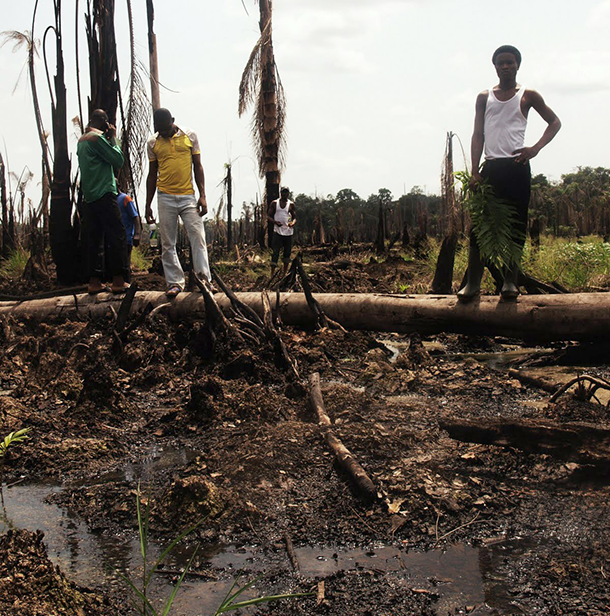
Nigerians in a wetland covered in oil (Photo: Sosialistisk Ungdom (SU), Flickr CC BY-ND 2.0)
CURWOOD: It’s Living on Earth, I’m Steve Curwood. Environmental campaigners often court trouble when they oppose global companies that want to extract lucrative resources, and there’s no more extreme example than the Niger Delta, where oil companies have drilled since the 1950s. The most famous opponent was Ken Saro-Wiwa, who protested the pollution of Ogoni land by Royal Dutch Shell and other oil giants. Here’s part of a poem the wrote:
SARO-WIWA: Ogoni is the land; the people Ogoni;
The agony of trees dying in ancestral farmlands,
Streams polluting, weeping filth into murky rivers.
CURWOOD: Ken Saro-Wiwa also won the Goldman Prize, posthumously in 1995, after he was tried, convicted and hanged by Nigeria’s military government on trumped-up charges of murder. After his death, his family launched suits that accused Shell of human rights abuses under the US Alien Tort Claims Act. In 2009, Shell settled for over $15 million dollars. Well now Shell is back in court over its environmental record in the Niger Delta, this time both in Holland and the UK, where the parent company of Shell Nigeria is registered. Daniel Leader of the law firm Leigh Day is a litigator for one of the polluted communities affected by massive oil spills, and joins us on the line from London. Welcome to Living on Earth.
LEADER: Thank you very much.
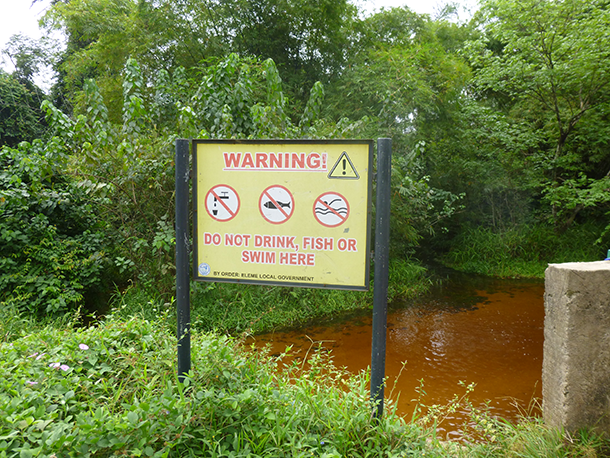
Ogale, Nigeria’s streams are so polluted that it’s not safe to swim in, let alone drink, the water. (Photo: Leigh Day)
CURWOOD: So tell us about these lawsuits that the Nigerian communities have brought against Shell. Who's involved and the basis for it?
LEADER: So, we're bringing these suits on behalf of two different communities that are fairly close to each other, both are outside the oil hub in southern Nigeria, the town of Port Harcourt. One is called the Ogali community and one is called the Bille community. In essence, the complaint of the Ogali community is that they've suffered from 40 different spills over the last 23 years, and that every aspect of their community is polluted. And there are signs that have been erected all over the community saying they can't swim, they can't drink, they can't fish, they can’t farm, and they want Shell to clean up their oil. And to date, there has been no proper cleanup of the spills. So, they have decided to take the case to the English courts against the parent company for the simple reason that they just cannot get justice through the Nigerian system because the Nigerian regulatory system is so weak.
CURWOOD: So, what does the Niger Delta look like and how much has been affected by these oil spills?
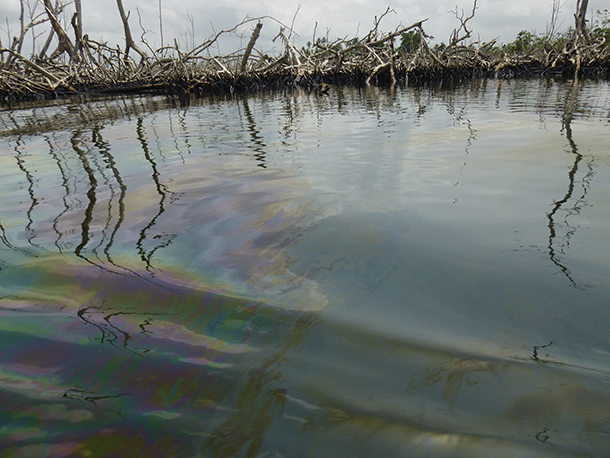
An oil slick in a dead mangrove forest (Photo: Leigh Day)
LEADER: The Niger Delta used to be a very beautiful coastline, it was full of mangrove swamps and fishing communities and farming communities and now it is devastated by vast tracts of land which has been completely covered in oil. I think the figure is that the Niger Delta has suffered the equivalent of the Exxon Valdez disaster in terms of the amount of oil that's been spilled every year for the last 50 years, something like 13 million barrels of oil have spilt into the environment in the Niger Delta. And it's a problem that seems to be getting worse, not better.
CURWOOD: So, it's hard to bring back nature. What exactly are you suing for here? What can be done to repair this?
LEADER: Well, things can certainly be done. The oil companies need to start improving the infrastructure, maintaining it so it doesn't leak, and that includes taking measures to protect it against vandals who come in and tap into the line. Secondly, they need to be cleaning up the oil in these communities, which is polluting them so badly. That needs to happen.
CURWOOD: Tell me about the different responsibilities of the Nigerian government here versus Royal Dutch Shell, Shell Oil. My understanding is that Nigeria is the big owner here.
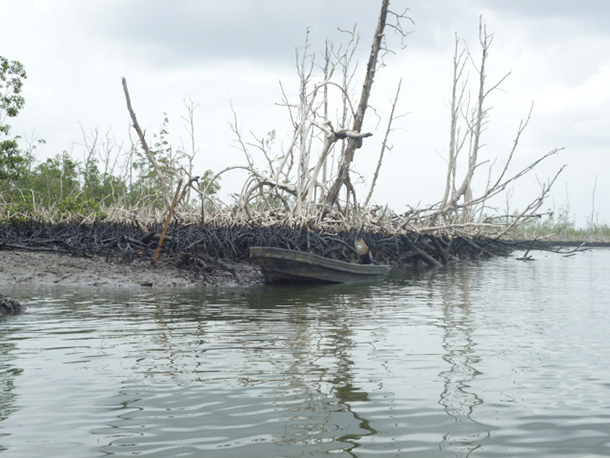
A boat covered in oil in Bille, Nigeria (Photo: Leigh Day)
LEADER: The Nigerian government operates a joint venture in which they are the majority shareholder and Shell owns roughly a third of the shares. The joint venture owns the assets, the pipelines, the oil wells, the flow station with the manifolds, but they are operated by different partners in the joint venture. So Shell, will operate one pipeline, Total will operate another. And the law is very clear, if oil spills from your pipeline that you are operating, you are responsible for cleaning it up. It's the ‘polluter pays’ principle and the ‘polluter cleans up’ principle. So we are just simply asking Shell to do what they are required to do under Nigerian law.
CURWOOD: Why have you brought this action in the UK, rather than Nigeria?
LEADER: The real problem is that you can't get justice through the Nigerian system. The courts are very inefficient, they're corrupt. There is no mechanism which will allow for group claims on behalf of many thousands of people who’ve been affected by oil spills. There's not a chance that Shell would be forced to clean up. They would tie the case up in technicalities. It would take 20 years to get through the system, they would argue every point, and it's the kind of thing that they can't do in the legal system here.
CURWOOD: How much in terms of financial compensation are you seeking in the present case?
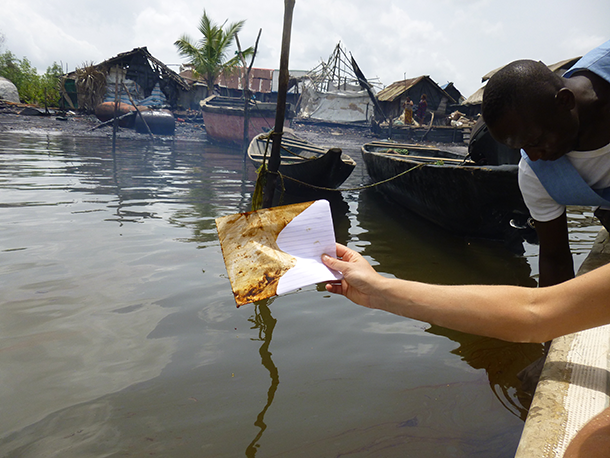
The water in Bille, Nigeria was brown after a recent oil spill. (Photo: Leigh Day)
LEADER: Well, the primary objective is to get Shell to clean up. The clean up costs would be very extensive, they would run into hundreds of millions. On top of that, there is a compensation claim. Our estimates at the moment is that in both cases it will be tens of millions of pounds.
CURWOOD: What, if anything can the international community do to curb this issue? What is the international community doing to curb this problem?
LEADER: Well, the United Nations Environmental Program did a very, very detailed report into pollution in Ogoni land in the Niger Delta area, and they found that there were really catastrophic levels of pollution that the communities were living with and in some cases emergency water needed to be shipped into communities because they were drinking from poisoned wells. The United Nations said, “Look there needs to be comprehensive clean up of these communities, can we agree a way forward with between the oil companies and the Nigerian government?” And that happened in 2011, and since then no one has cleaned up any oil. The communities continue to live in these horrifically polluted environments, and I understand that Ban-Ki Moon personally wrote to the Nigerian president on several occasions insisting that he does something about this, and still nothing. Ultimately, no one wants to stump up the cash, which it's going to take for the clean up of these communities. There's just simply not political will and the oil communities don't want to pay for it either. Which is why we're taking this matter to the courts in the UK because the law is clear - the oil companies have to clean up their oil. We don't need an overarching political process to resolve that issue. Our clients are tired of waiting around for that political process to happen, it's been five years. So, those are saying, “This is the law, these are our communities that are being destroyed by your oil. Clean it up”.
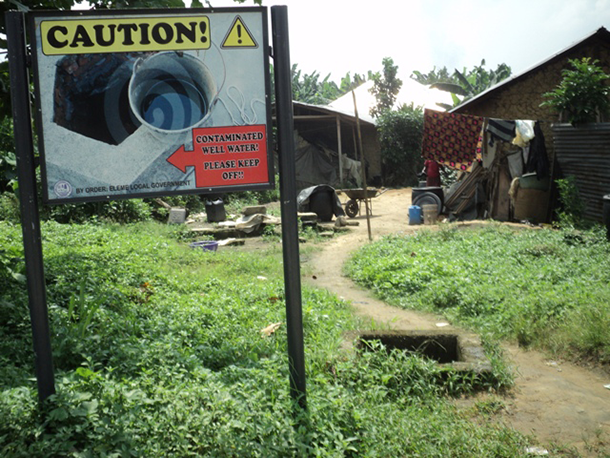
Signs cautioning residents not to use their well water are a frequent sight in Ogale, Nigeria. (photo: Leigh Day)
CURWOOD: Daniel Leader is a partner at Leigh Day and a litigator representative to Nigerian communities against Royal Dutch Shell for oil spills in the Niger Delta. Thanks for taking the time with us today.
LEADER: It's a great pleasure. Thanks for inviting me.
CURWOOD: We called Shell Oil in London asking for comment. A spokesperson said the case should be heard in Nigeria. The full statement is on our website loe.org.
Shell Petroleum Development Company of Nigeria (SPDC) Statement
A spokesperson for the Shell Petroleum Development Company of Nigeria (SPDC) said: “We are at an early stage of reviewing the claims made by the Bille and Ogale communities. Both Bille and Ogale are areas heavily impacted by crude oil theft, pipeline sabotage and illegal refining which remain the main sources of pollution across the Niger Delta. Ogale is in Ogoniland and it is important to note that SPDC has produced no oil or gas in Ogoniland since 1993. Access to the area has been limited following a rise in violence, threats to staff and attacks on facilities.
“The Bille and Ogale communities have chosen to bring these claims in the UK instead of in Nigeria, whose laws govern our operations. It is our intention to contest the jurisdiction of the English court over these claims. We believe that allegations concerning Nigerian plaintiffs in dispute with a Nigerian company, over issues which took place within Nigeria, should be heard in Nigeria.”
“Furthermore, Ogoniland is the area covered by the United Nations Environment Programme’s Environmental Assessment (‘the UNEP report’) of 2011. UNEP presented its recommendations as an opportunity to bring a culture of multi-stakeholder cooperation to Ogoniland, a process in which SPDC has been involved. SPDC has also initiated action to address all the recommendations directed to it in the UNEP report as operator of the SPDC Joint Venture. In mid-2015 SPDC JV, along with the government, UNEP and representatives of the Ogoni community, agreed to an 18-month roadmap to fast-track the environmental clean-up and remediation of Ogoniland which includes a governance framework.
“These steps have been widely lauded across civil society in Nigeria and have been welcomed by members of the Ogoni community itself. Asking the English court to intervene and order remediation activity covering the same ground as the UNEP implementation plan is a direct challenge to the internal political acts and decisions of the Nigerian State, and its sovereign right to determine, within its own territory, the appropriate future path for the Ogoni community.”
Statement provided by Rachel Power of Shell International Ltd.
Related links:
- Leigh Day law firm is bringing the suit
- Other lawsuits faced by Shell for Nigerian oil spills
[MUSIC: Miles Davis Ensemble, “The Pan Piper,” on Miles Davis & Quincy Jones Live At Montreux, Gil Evans (Bopper Spock Suns Music), Warner Bros.]
Sanders and Clinton on Flint Crisis and Fracking

Senator Bernie Sanders spoke at a rally in Traverse City, Michigan a few days before the Democratic debate in Flint, Michigan and his subsequent victory in the Michigan primary. (Photo: Todd L Church, Flickr CC BY 2.0)
CURWOOD: Senator Bernie Sanders scored a surprise victory in the recent Michigan primary, as the Democratic race for president continues. Environmental issues have been mostly absent as concerns on the campaign trail so far, even in the Democratic debates. But water issues took center stage at the opening of the recent democratic debate on CNN in Flint, Michigan. Thousands have been poisoned by lead contamination in Flint’s water, due to cost-cutting measures ultimately laid at the door of Michigan’s Republican Governor Rick Snyder. Senator Sanders.
SANDERS: I believe the governor of this State should understand his dereliction of duty was irresponsible; he should resign.
[APPLAUSE]
CURWOOD: Senator Sanders called for more funding to improve the nation’s water infrastructure and ensure that something like this never happens again. Secretary Clinton agreed that the Governor Snyder should resign, and called on the federal government to increase funding.

Secretary Hillary Clinton at a rally in New Hampshire. (Photo: Gage Skidmore, Flickr CC BY-SA 2.0)
CLINTON: The State should also be sending money immediately to help this city.
[APPLAUSE]
I know the state of Michigan has a rainy day fund for emergencies. What is more important than the health and wellbeing of the people, particularly children? It is raining lead in Flint, and the state is derelict in not coming forward with the money that is required.
[APPLAUSE]
CURWOOD: The environment also came up later in the debate when a University student asked Hillary Clinton about her stance on fracking for natural gas.

During the March 6th debate in Flint, Sanders and Clinton called for the resignation of Michigan Governor Rick Snyder. (Photo: Michigan Municipal League, Flickr CC BY-ND 2.0)
CLINTON: You know, I don’t support it when any locality or any state is against it, number one. I don’t support it when the release of methane or contamination of water is present. I don’t support it — number three — unless we can require that anybody who fracks has to tell us exactly what chemicals they are using. So by the time we get through all of my conditions, I do not think there will be many places in America where fracking will continue to take place. And I think that’s the best approach, because right now, there places where fracking is going on that are not sufficiently regulated. So first, we’ve got to regulate everything that is currently underway, and we have to have a system in place that prevents further fracking unless conditions like the ones that I just mentioned are met.
COOPER: Senator Sanders, you...
SANDERS: My answer...my answer is a lot shorter. No, I do not support fracking.
[APPLAUSE]
And by the way, by the way, Anderson, I’m glad you raised the issue of climate change, because the media doesn’t talk enough about what the scientists are telling us, and that is, if we don’t get our act together…..
[APPLAUSE]
...the planet that we’re gonna leave our children may not be healthy and habitable. I have introduced the most comprehensive climate change legislation in the history of the Senate, which, among other things, calls for a tax on carbon, massive investments...
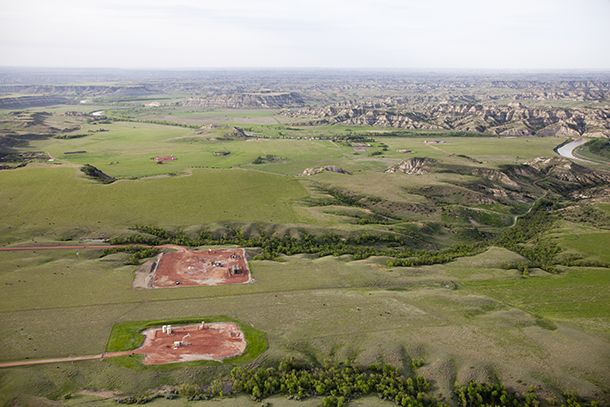
Clinton and Sanders clashed over fracking during the debate. (Photo: Chris Boyer / NPCA Photos, Flickr CC BY-ND 2.0)
[APPLAUSE]
...in energy efficiency, wind, solar and other sustainable energy.
COOPER: Senator...
SANDERS: This is a crisis we have got to deal with now.
[APPLAUSE]
CURWOOD: Thanks to CNN for the audio from the Flint debate.
Related links:
- Clinton Doubles Down Against Fracking in Debate, Raising Alarms
- How Bernie Sanders Won Michigan
- Clinton and Sanders call for Michigan Governor Rick Snyder to resign
[MUSIC: Jim Guttman’s Bessarabian Breakdown, “Beregovski 90-Skocne,” An Everything Bagel For Your Ears, Boston Jewish Music Festival.]
Rising Seas and Real Estate Prices in Fort Lauderdale

Fort Lauderdale is undergoing a construction boom in anticipation of 50,000 more residents -- about a third of its current population -- in the next fifteen years. (Photo: Katherine Bagley)
CURWOOD: Sea level rise is one of the most obvious and ominous effects of global warming, and that makes living in low-lying coastal areas increasingly risky. Yet some of the very places that will be most affected by rising seas are undergoing real estate booms. Among them is South Florida, where developers are cashing in on new housing near the sea, though the people who buy those homes could be buying a lot of trouble.
STODDARD: Ultimately if the water is going to cover us, real estate prices are going to go from high to zero.
CURWOOD: That’s Mayor Philip Stoddard of South Miami who told us about his worries – and ideas of what’s likely to happen.

A seawall undergoes repairs along one of Fort Lauderdale’s numerous canals. (Photo: Katherine Bagley)
STODDARD: My own prediction and I could be wrong on this, but this is my prediction, is that there will be some natural event, a hurricane, a big storm surge — I call these primary disruptors—and one of these primary disruptors is going to shake people, just shake their confidence, and some people are going to start moving out. And at that point, it's anybody's guess what happens to real estate prices. Once the perception is there, that it’s not a safe place to park your money for real estate, prices drop.
CURWOOD: A ways north from South Miami you’ll find “the Venice of America”, Fort Lauderdale.
With its 165 miles of canals, this charming city is also undergoing a real estate boom, even though those very canals make it particularly vulnerable to rising seas, as much of the city of close to sea level already. Writer Katherine Bagley reported on Fort Lauderdale’s real estate bonanza and impending sea level rise for InsideClimate News and joins us now. Kat, welcome to Living on Earth.
BAGLEY: Thanks for having me.

The streets of Fort Lauderdale flood with seawater a couple of times a year, during “king tide” events, when the sun, moon, and the earth align. (Photo: Katherine Bagley)
CURWOOD: Talk to me about Fort Lauderdale's growth? How much is Fort Lauderdale projected to grow over these next several decades, at least according to the Chamber of Commerce.
BAGLEY: It's expected to grow by a third. There's about 50,000 people that are expected to move to Fort Lauderdale in the next 15 years and currently the city doesn't have the housing to be able to accommodate those people so there's this massive building boom happening within city limits. There's skyscrapers going up and new condos, new apartment buildings. The city is really transforming itself to accommodate this huge influx of population.
CURWOOD: Now, of course, there are many cities along the coastline. Why is Fort Lauderdale so vulnerable to sea level rise?
BAGLEY: Fort Lauderdale, as you had mentioned, is the Venice of America, so it has 165 miles of canals that wind its way really through the innards of most parts of the city, and like most of South Florida it sits on top of a limestone bedrock which is a very porous bedrock, and it means that when sea levels rise they not only creep over sea walls, they also actually creep through the underlying bedrock of the city and so you'll have water that will creep under homes and into streets. It really affects almost every part of the city. The water is really the heart and soul of Fort Lauderdale and it could be its downfall in the end, unfortunately.
CURWOOD: So to what extent is flooding already happening in Fort Lauderdale?
BAGLEY: Right now the worst flooding that you see is around these king tide events which is when the Earth, the sun, and the moon all align. They happen a few times a year and that's when high tide is 18 inches above normal. Streets flood, yards flood, critical infrastructure is at risk. Because sea level has risen 8 inches in the last 100 years that king tide is 18 inches on top of sea level rise, so it's getting worse and worse and worse every year.
CURWOOD: So how was the real estate market reacting to this increased risk, this increased reality of flooding?
BAGLEY: The real estate market itself, I mean, like I said, it's booming, and as of right now construction codes in the city require that buildings are built one foot above the floodplain but no more than that. I had city officials telling me it's true that some of the buildings that are going up now might be dealing with severe flooding in 30 years, and that's the lifespan of a mortgage.
CURWOOD: What kind of disclosure is there to people who are buying these properties about the flood risk?
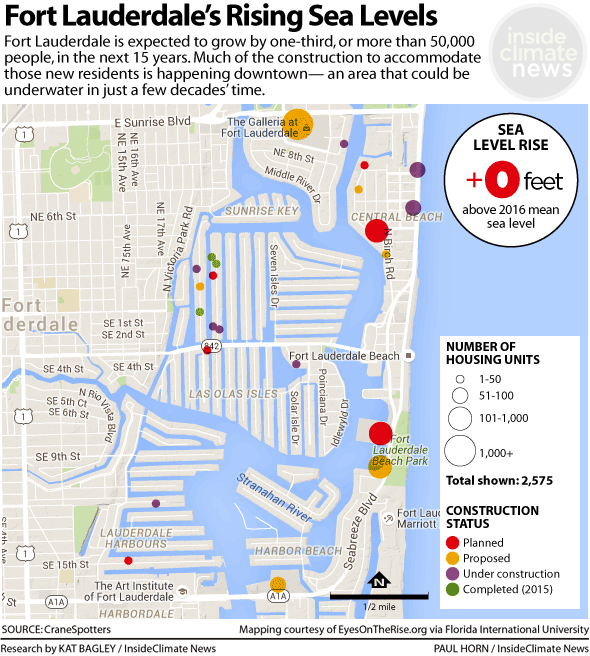
What sea level rise looks like in Fort Lauderdale. (Photo: courtesy of InsideClimate News)
BAGLEY: There's not really any disclosure. The real estate community doesn't really want to talk about this and so they're not required to talk about flood risk. When you buy a house and there's lead paint you have to get a disclosure form, there's nothing like that for sea level rise, climate change and flood risk.
CURWOOD: Now, how do the locals you talk to feel about the fact that sea levels are projected to rise so much and flooding is just going to become more and more common in Fort Lauderdale?
BAGLEY: The last several years those king tides have been a real wake up call and so most people in South Florida know about climate change, they're aware that it's happening, and city officials are racing to take action. Fort Lauderdale officials are putting in a bunch of new flood mitigation measures, things like one-way valves to stop sea levels from creeping onto roads. They are taking steps to reduce their greenhouse gas emissions, but it's a really tough battle.

Canal water spilled over a seawall into a Fort Lauderdale backyard during a recent king tide event. (Photo: Katherine Bagley)
CURWOOD: What about the low income and my minority communities there. Often around the world, they're on the front lines of climate disruption. What's the situation there in Fort Lauderdale?
BAGLEY: So the low income communities in Fort Lauderdale are actually at the highest point of elevation in the city and so right now they are the safest. The question becomes when the waterfront properties start flooding, the higher income properties, where are those people going to want to move? And they're going want to move into the higher elevation areas. One of the experts that I talk to termed it "climate gentrification" and when you have sea level rise and the oceans rising to the east and you have the Everglades to the west, there's really no place for these people to go.
CURWOOD: So how does the city of Fort Lauderdale's response to this compare to the state’s response on the dangers of climate disruption?

Luxury waterfront properties in Fort Lauderdale tend to be owned by the wealthiest residents of the city; as they relocate due to sea level rise, lower-income populations may be priced out of their homes on higher ground. (Photo: Katherine Bagley)
BAGLEY: Fort Lauderdale and South Florida are very much alone in their battle against climate change. Tallahassee, the state capital, Gov. Rick Scott, most of the state legislators are very much against climate action. Gov. Scott has reversed most of the climate programs that previous governors have put in place. They've banned the term “climate change” in government work, and so really communities in Florida that want to deal with this issue either have to band together with their surrounding areas which is what South Florida has done or they really have fight it alone. They don't have much support from the state.
CURWOOD: So how many individuals who own places there are starting to smell the coffee and quietly putting their places on the market so they can get some money for them now while there still is money to be had?
BAGLEY: I think you're seeing a few people start to do that, but of course you haven't seen this mass exodus, and even if they were, there would be plenty of people willing to come in and buy their property and take their place.
CURWOOD: So, property values are staying flat at least, maybe even rising?

Katherine Bagley reported the story on Fort Lauderdale’s real estate boom for InsideClimate News. She is now an editor with the online magazine Yale Environment 360. (Photo: courtesy of Katherine Bagley)
BAGLEY: They're definitely rising. Prices are really doing well in South Florida especially considering they were just in a recession a couple years ago. They're doing remarkably well, but I think most people would tell homebuyers that it's not a great investment. When you look at what could happen with sea level rise in the next 30 years you know it's kind of daunting to think about buying a house and it's not just the value of the house, it's the flood insurance. At some point our flood insurance premiums are going to increase and some economists have said that the premiums could rise so much that nobody would be willing to buy a house.
CURWOOD: Katherine Bagley reported on Fort Lauderdale for Inside Climate News and is now an editor at the online magazine Yale e360. Thanks so much, Kat.
BAGLEY: Thank you so much for having me, Steve.
Related links:
- Katherine Bagley’s article, “Rising Seas Pull Fort Lauderdale, Florida’s Building Boomtown, Toward a Bust”
- Sea level rise simulator
- About Katherine Bagley
- Living on Earth’s previous discussion on the climate risk for real estate values in south Florida
[MUSIC: Ray Charles, “Laughin’ and Clownin’, on Singular Genius: The Complete ABC Singles Sampler, Sam Cooke (ABKCO Music), Concord Records]
CURWOOD: Coming up...heading to the bottom of the world for icebergs and more. That's just ahead on Living on Earth. Stay tuned.
ANNOUNCER: Funding for Living on Earth comes from United Technologies, a provider to the aerospace and building systems industries worldwide. UTC Building & Industrial Systems provides building technologies and supplies container refrigeration systems that transport and preserve food and medicine with brands such as Otis, Carrier, Chubb, Edwards and Kidde. This is PRI, Public Radio International.
[CUTAWAY MUSIC: Mongo Santamaria, “Jeanie’s Tune,” on Ole Ola, Mitch Frohman (Mongo Music), Concord Picante.]
Beyond the Headlines
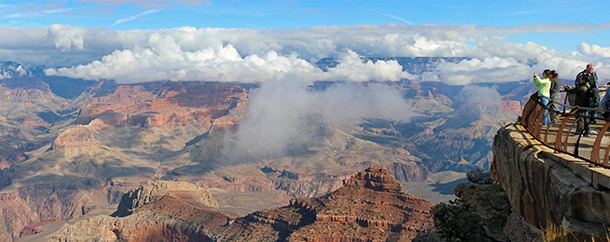
Amid outcries from the Navajo community and environmental groups, plans for a large development near the entrance to Grand Canyon National Park have been scrapped. (Photo: Grand Canyon National Park, Flickr CC BY 2.0)
CURWOOD: It's Living on Earth, I'm Steve Curwood. Now we’ll take a trip to Conyers Georgia to explore the world beyond the headlines. Peter Dykstra of Environmental Health News, ehn dot org and DailyClimate dot org has been checking things out there – hi there, Peter!
DYKSTRA: Hi, Steve. The Flint Michigan story just gets bigger, and now it’s become a political juggernaut. As you pointed out earlier, the Democrats staged a debate in Flint, and highlighted Republican Governor Rick Snyder’s mishandling of the crisis.
CURWOOD: Yeah, but how fair is it fair to single out the Republicans and turn this into a political football?
DYKSTRA: It’s not fair at all. Not when President Obama’s EPA ignored the warning signs in Flint, just like the state government did. The Regional EPA Administrator lost her job over this. But if you want to not turn this into a political football, I’d suggest you don’t do what Chris Christie just did.
CURWOOD: Oh, what was that?
DYKSTRA: Well Gov. Christie gets both criticized and praised for his ability to shift with the political winds. With all this attention on a lead-poisoning tragedy, it maybe wasn’t the best timing for him to sink a measure that would have added 10 million dollars to a fund to combat lead poisoning risks in New Jersey. Christie says the state already spends plenty on lead abatement, and adds that the lead issue has been “over-dramatized.”

New Jersey Governor Chris Christie vetoed a bill that would have funded lead poisoning prevention in the state. (Photo: Gage Skidmore, Flickr CC BY-SA 2.0)
CURWOOD: Yeah but you know, New Jersey could easily spend 10 million dollars on just ten kids over their lifetimes if they get lead poisoned bad enough.
DYKSTRA: Right.
CURWOOD: What’s next?
DYKSTRA: A threat that’s ended near the Grand Canyon, but another threat that just won’t go away. The tiny town of Tusayan near the entrance to Grand Canyon National Park, has about 500 people and its businesses pretty much exist to serve Grand Canyon tourists. For years, local and national groups have weighed in on a proposed mega-development there, businesses, hotels, and 2,200 new residences.
CURWOOD: Hmm, doing the math here that’s what --four times as many new homes as the current number of people there? What’s up?
DYKSTRA: The proposal was cut down by the U.S. Forest Service, which manages some of the land surrounding the National Park. There was some strong support for the development in town, but many locals and national groups and nearby tribes opposed it and carried the day.
CURWOOD: Ah, so some good news then?
DYKSTRA: Ah, but wait! Six miles away from Tusayan, there’s a planned uranium mine. In 2012, the Interior Department banned new mining claims near the canyon, but a mining firm hopes to begin digging on a claim approved back in the 1980’s.
CURWOOD: Uhh, uranium mining has a pretty ugly history in that part of the country, particularly on Navajo land. I mean people are still suffering contamination from mine tailings that the uranium industry left behind.
DYKSTRA: Right, there are about a dozen existing, approved claims that could open up in Northern Arizona unless the courts or Federal agencies intervene.
CURWOOD: Hmm, hey what do you have for us on the history vaults this week?
DYKSTRA: I’ve got a bizarre case of panic, rumor control, and the damage done, from this week back in 1989. Amid protests against Chile’s authoritarian government, the FDA receives threats that grapes exported to the US from Chile have been poisoned. There’s extensive testing, no poison found, business as usual, but after a second set of threats, two – just 2 – Chilean red grapes are reportedly found to be laced with cyanide.
CURWOOD: And mayhem ensues – over two grapes?

This week in 1989, the Food and Drug Administration received threats that red grapes from Chile had been laced with poison. (Photo: Richard Howe, Flickr CC BY 2.0)
DYKSTRA: Serious mayhem. Grapes were pulled from grocery stores and restaurants, a lot of Americans stopped eating grapes no matter where they came from, and in one magnificent bit of overreach, a mother, horrified to learn about the cyanide after she had packed grapes in the kids school lunches, had the Oregon State Police chase and pull over her kids’ school bus and apprehend the menacing fruit.
CURWOOD: And I remember that Chile – they really took a beating over this.
DYKSTRA: To the tune of about a third of a billion dollars. The FDA banned all Chilean fruit exports for a while, but despite intensive testing, no more poison was found and even the testing of those two grapes was called into question, since cyanide couldn’t have stayed potent on the three-week boat trip from Chile.
CURWOOD: Hmm, sounds like a very dangerous trick that never got solved -- maybe some unfair competition huh?
DYKSTRA: Who knows. But Steve, I’ve got a final sad note. We lost an amazing journalism colleague this week, photographer Gary Braasch. Gary devoted years to documenting the causes and the consequences of climate change from places like the Wyoming coalfields and the melting Arctic. He died while snorkeling in another great place at risk, the Great Barrier Reef. He’ll be missed, but his work lives on.
CURWOOD: Indeed, he was a pretty amazing artist. Peter Dykstra is with Environmental Health News EHN.org and Dailyclimate.org. Thanks Peter! Talk again soon.
DYKSTRA: Alright Steve thank you, talk to you soon.
CURWOOD: And there’s more on these stories at our website Loe.org.
Related links:
- Governor Christie defends veto of lead-poisoning bill, calls problem ‘over-dramatized’
- Federal authorities reject plan for development with 2,200 homes near Grand Canyon
- Feds get data to check on mining’s effect near Grand Canyon
- Chile May Sue U.S. Over Grape Ban
- Do You Dare To Eat A Peach? Or an apple, or a grape?
- Gary Braasch’s photography
- Gary Braasch’s climate change website
[MUSIC: Rosalie Gerut, “Sarah’s Lullaby and Hagar’s Lament,” An Everything Bagel For Your Ears, Boston Jewish Music Festival.]
Emerging Science Note/Carbon-Cleaning Icebergs

When icebergs melt, algal blooms form, storing carbon beneath the sea. (Photo: Vincent Moschetti, Flickr CC BY-NC-ND 2.0)
CURWOOD: Just ahead...penguins in love and in trouble. But first this note on emerging science from Jaime Kaiser.
[SCIENCE NOTE THEME]
KAISER: The giant icebergs that break off the Antarctic ice sheet contribute to rising sea levels and threaten a host of environmental consequences. Yet a new study shows these bergs also offer a surprising upside – an occasion where nature combats global warming.
A team of researchers from the University of Sheffield in England caught on to the benefit of melting icebergs using satellite images of 17 “giants”, some over 11 miles wide, as they drifted through the southern ocean. The images revealed swaths of algae where the bergs had been. The algae’s the result of iron and other nutrients the ice releases as it melts. This ocean fertilization can last over a month after the iceberg has drifted on. While algal growths lead to hypoxic “dead zones” in places like the Northern Gulf of Mexico and river ecosystems, in the Southern ocean surrounding Antarctica it’s a different story. Here, the blooms slow down warming with their knack for sequestering carbon, that then sinks to the bottom of the sea as the algae mats die.
At the moment, global greenhouse gas emissions are increasing at about 2% a year. But Grant R. Bigg, one the study’s authors, estimates that without these giant melting icebergs, and the carbon they help store deep under the sea, emissions would be growing at 2.1 or 2.2 percent each year.
But Professor Bigg warns that trying to geo-engineer algal blooms probably wouldn't be worth the cost, nor could human attempts penetrate the deeper ocean layers as effectively as icebergs. So a campaign to sprinkle iron across the world’s oceans is no substitute for reducing our carbon footprint.
That's this week's note on emerging science. I'm Jaime Kaiser.
Related link:
The study, “Enhanced Southern Ocean marine productivity due to fertilization by giant icebergs”
Penguin Colony Uprooted by Ice in a Warming World
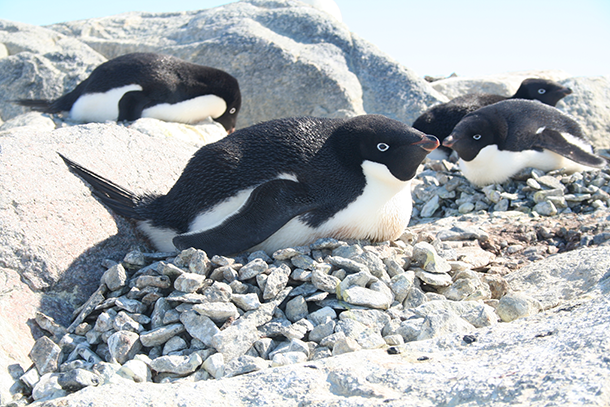
Adelie penguins on nests, Cape Denison. (Photo: Kerry-Jayne Wilson)
CURWOOD: Well, an iceberg is key to our next story – about penguins. One long-established research team studies how Adelie penguins are affected by climate change in Antarctica. But when the scientists returned to the Cape Denison colony during the 2013-2014 Antarctic summer, they found just a tiny fraction of its former population. Kerry-Jayne Wilson is one of those researchers from Lincoln University at Canterbury in New Zealand and she explains what happened.
WILSON: In 2010, this giant iceberg, B09B, stranded about 60, 70 kilometers offshore from Cape Denison and over the next couple of years, fast ice formed, so it’s attached fast to the land, so that now the colony is isolated from the sea by 60 or more kilometers of fast ice.
CURWOOD: That meant that the penguins were cut off from their food supply and couldn't feed their chicks. I asked Kerry-Jayne to describe the Adelie penguin.
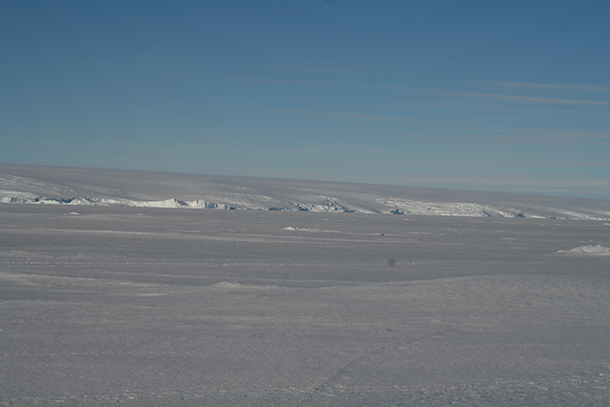
The Antarctic continent coastline. The sea ice in the foreground would usually be open water. (Photo: Kerry-Jayne Wilson)
WILSON: Well, it's your characteristic black and white Antarctic penguin, white on the front, black on the upper surface, black face and a very pronounced white ring around the eye.
CURWOOD: And how tall are they?
WILSON: They're about 60 centimeters tall and that's just above your knee.
CURWOOD: So what did you find when you went to the nesting area that the colony uses?
WILSON: Well, it was quite a shock. Adelies are very aggressive normally, and very active penguins. Normally when you're working with Adelies they will come at you if you get too close to the colony, hit you with their flippers, try biting you, and these are usually very noisy, and the colony was silent. They were very subdued, sitting quietly and hardly acknowledged our intrusion. There were far fewer penguins than we would have expected to be there, so a reduction of the numbers coming ashore to breed and the breeding success.
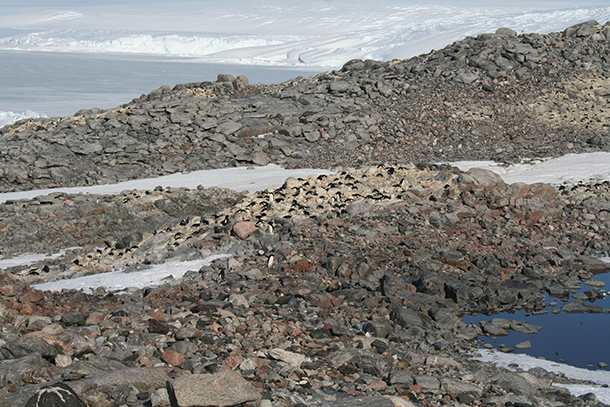
Adelie penguin colonies at Cape Denison. The fast (sea) ice in the background should be open water. Note the guano stained areas used in recent years but no longer used by nesting penguins. (Photo: Kerry-Jayne Wilson)
CURWOOD: What about the chicks that you saw? How old were they?
WILSON: We were there on virtually the day that hatching started. We saw a couple of just newly hatched chicks, but the chicks from last year were freeze dried - that's what happens in the Antarctic, anything dead will get freeze dried - and there were literally thousands, just almost a carpet of dead chicks around the colonies.
CURWOOD: Oh my. So, what do you think happened to the penguins that had been there? You say you saw just a few. Where did the others go?
WILSON: Well, that we don't know. It's highly unlikely that they’ve died. It's most likely that they didn't bother to come back and attempt to breed. The really clever ones assessed the situation, assessed it as a year in which they will fail, so why bother starting. The ones that aren't quite so clever have made the long trip to the colony and have attempted to breed and have failed, either at the egg stage or the chick stage.
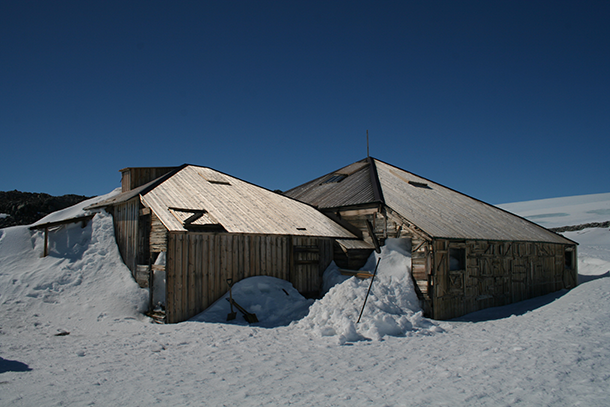
“Mawson’s Huts” are a collection of buildings at Cape Denison, erected by explorer Sir Douglas Mawson during the 1911-1914 Australasian Antarctic Expedition. (Photo: Kerry-Jayne Wilson)
CURWOOD: So, if they didn't come back, where do you think they went?
WILSON: They'll just remain at sea.
CURWOOD: Really, how long can they live at sea?
WILSON: Oh, years. The only reason penguins come back to the colony is to breed. So, if it's not suitable to breed, then just remain at sea out on the pack ice. So ice floes, that are moving at the whim of the currents in the wind. Some may have gone to other colonies closer to open water, but my guess is that most just didn't bother and cut their losses.
CURWOOD: Kerry-Jane, there's been a lot of conflicting media coverage of this story, especially about whether the penguins died or moved on. How accurate do you think the coverage in general has been?
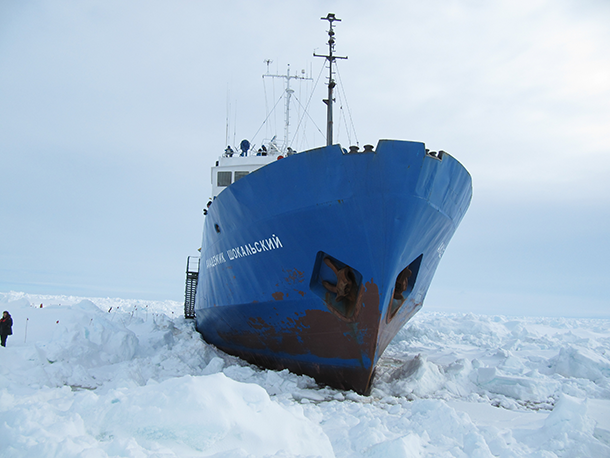
The Akademik Shokalskiy beset in pack-ice within sight of the Hodgeman Islands a few days after the researchers completed their penguin counts. The ship was stuck motionless in the ice for 10 days over Christmas and the 2014 New Year. (Photo: Kerry-Jayne Wilson)
WILSON: It's been really disappointing. I don't know where the 150,000 dead penguins came from, it didn't come from our paper. We did not suggest that adult penguins were being killed by this event. So some media outlet came up with 150,000 dead penguins and it's been repeated over and over and over again. And we have recently put a statement online correcting the misreporting of our work.
CURWOOD: Tell me, how well off are the Adelie penguins in general? How are they doing?
WILSON: Adelie penguins occur right around the Antarctic continent. In the northern most parts of continent on the Antarctic Peninsula south of South America. Adelie penguins are in decline due to climate warming. The water temperature is going up, there's less ice available. In the southern part of Antarctica around the Ross Sea region, Adelie numbers have been going up. Around the area that we were working, around east Antarctica, Adelie numbers tend to be stable, but the prediction is they will decline somewhat with changing pack ice conditions.
CURWOOD: To what extent do you think climate change played a role in this massive iceberg that blocked their ready access to food there at Cape Denison?
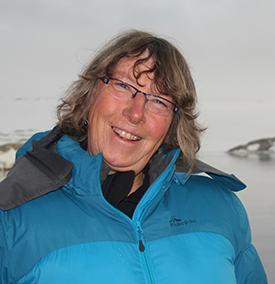
Kerry-Jayne Wilson has studied penguins and other seabirds for over 40 years. (Photo: courtesy of Kerry-Jayne Wilson)
WILSON: Well, the Antarctic is warming. It's still very cold, but it has warmed by a degree or so, and that causes the ice on the continent to move off the continent faster. So around Antarctica there are some huge ice shelves, these are floating shelves of glacier ice. And from time to time, icebergs break off the ends of these. What we believe at this stage is that the breakoff of mega-icebergs is becoming more frequent. So what we believe is going to happen in the next century or so with climate warming is an increase in the frequency of these dire events.
CURWOOD: Kerry-Jane Wilson is a retired lecturer of ecology at Lincoln University in New Zealand. Thank you so much for taking the time with us today.
WILSON: OK. You're welcome.
Related links:
- Journal article, “The impact of the giant iceberg B09B on population size and breeding success of Adélie penguins in Commonwealth Bay, Antarctica”
- “Death of a Colony”: the research team’s statement on media coverage
- About the Adelie penguin
- About Kerry-Jayne Wilson
Stealing Dirt: A Thieving Penguin
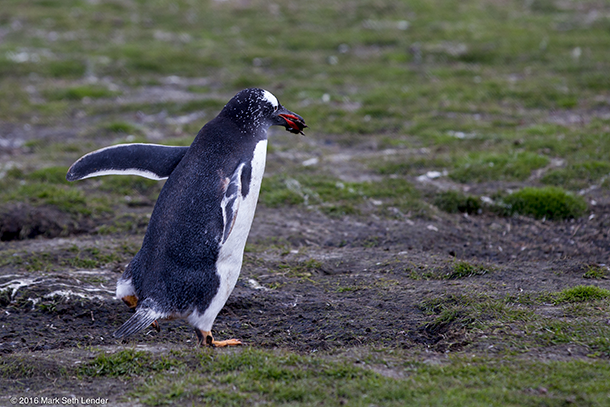
The Gentoo penguin stealing dirt (Photo: Mark Seth Lender)
CURWOOD: We head north of Antarctica now, for a different penguin in a different land. Gentoo Penguins can be found in the Falkland Islands, but it’s a comparatively sparse population, especially early in the breeding season. At a colony on Carcass Island, writer Mark Seth Lender discovered that a penguin’s sense of how much space is enough – and how close is too close – can be unpredictable even to the other penguins.
Stealing Dirt
Carcass Island, West Falklands
© 2015 Mark Seth Lender
All Rights Reserved
[SOUNDS OF GENTOO PENGUIN COLONY ON CARCASS ISLAND]
LENDER: Gentoo Penguin is building his nest from the only thing at hand: Dirt. In chunks. By the beakful. Brown clingy stuff that plasters neatly to the purpose he has in mind. He bends to pick, then carry, then drop at Her penguin feet. And She accepts every small measure. Like a treasure. With bright orange bill she then mills and turns the shape that rises like a hand-built pot. Round and round. Well-contrived. Perfect for their well-laid plans, the seat, the center of things that are to come.
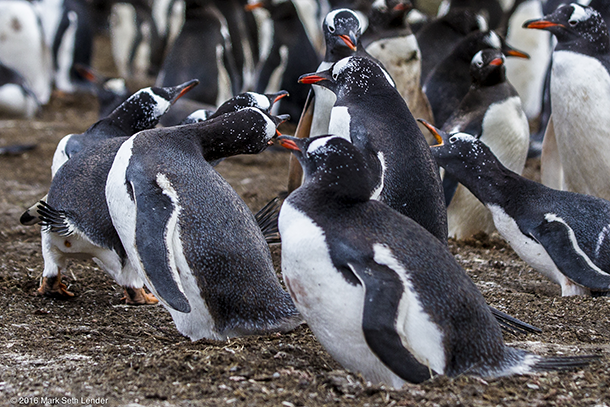
The offender gets bitten (Photo: Mark Seth Lender)
There would be should be plenty (dirt is all there is here). Except (for reasons known only to his penguin-self) Gentoo Penguin finds the ground over there more, and better, than the ground over here; and he makes his shuffling rounds.
He’s getting away with it. No one tries to stop him. In the Southern Hemisphere it is early days of spring. The clans that make this colony are thin and widely spaced and at the place he’s stealing from, no one’s home. And Gentoo’s left alone.
After he’s already crossed the open space from where the mud is always muddier to his own turf (where there is no turf but only mud), Gentoo makes a wrong turn. And every penguin in his very-own penguinhood tells him, “Penguin, get gone!” He jumps, from one, to collide, with another. They howl they peck they bat him with the flat of their muscular arms that once were wings. He leaps, he spins! And every penguin person wants a piece of him.
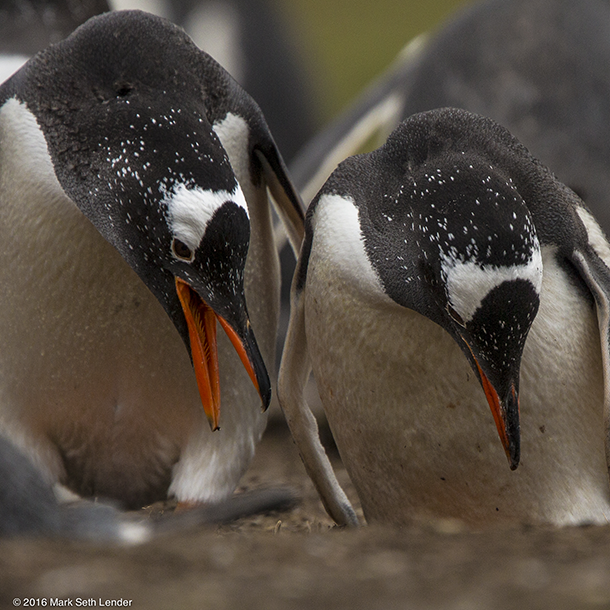
Gentoo penguins building their nest (Photo: Mark Seth Lender)
Safe, at last, his reward for all the dirty work he’s done is love. Paired, in perfect synchrony Gentoo Penguins rise, and pointing toward the sky they sing. Bending low they bow, then high, then side to side. And like the mariner he is, (most of his life spent at sea) he plies her broad ship’s keel of a back. She cranes her neck, they clasp, then grasp each other beak-to-beak. And in this ancient perfect circle of a pose they hold. And hold. And hold.
[MORE GENTOO COLONY SOUNDS]
CURWOOD: That's writer Mark Seth Lender. To check out his photographs of Gentoo Penguins in love and war, waddle over to LOE.org.
Related links:
- Mark Seth Lender’s personal website
- Read more about Gentoo Penguins at NatGeo
[MUSIC: Claire Jones/The London Mozart Players/English Chamber Orchestra, “Toss the Feathers,” on Claire Jones/Royal Harp Strings, traditional arr/Chris Marshall, Silva Screen Music]
CURWOOD: Next time on Living on Earth, burning fossil fuel causes global warming – and can make people sick.
VENKAT: What happens a lot with these patients is that either allergies due to air pollution or they get a virus of some sort--that really triggers them to require acute care.
CURWOOD: But as air here gets cleaner fewer people are falling ill.
That’s next time, on Living on Earth.
[MUSIC: Oscar Peterson, “If I Were a Bell,” on Compact Jazz: Oscar Peterson, Frank Loesser, PolyGram Classics & Jazz]
CURWOOD: Living on Earth is produced by the World Media Foundation. Our crew includes Naomi Arenberg, Bobby Bascomb, Emmett Fitzgerald, Helen Palmer, Lauren Hinkel, Adelaide Chen, Jenni Doering, Peter Boucher, Jaime Kaiser, and Jennifer Marquis.
Special thanks today to CNN, One Ocean Expeditions and Sandy Simon. Tom Tiger engineered our show, with help from John Jessoe, Jake Rego and Noel Flatt.
Alison Lirish Dean composed our themes. You can find us anytime at LOE.org - and like us, please, on our Facebook page - it’s PRI’s Living on Earth. And we tweet from @LivingOnEarth. I'm Steve Curwood. Thanks for listening.
ANNOUNCER1: Funding for Living on Earth comes you, our listeners, and from the University of Massachusetts Boston, in association with its School for the Environment, developing the next generation of environmental leaders. And from the Grantham Foundation for the protection of the environment, supporting strategic communications and collaboration in solving the world’s most pressing environmental problems. And Gilman Ordway for coverage of conservation and environmental change. And from Solar city, America’s solar power provider. Solar city is dedicated to revolutionizing the way energy is delivered by giving customers a renewable alternative to fossil fuels. Information at 888-997-1703. That’s 888-997-1703.
ANNOUNCER2: PRI. Public Radio International.
Living on Earth wants to hear from you!
Living on Earth
62 Calef Highway, Suite 212
Lee, NH 03861
Telephone: 617-287-4121
E-mail: comments@loe.org
Newsletter [Click here]
Donate to Living on Earth!
Living on Earth is an independent media program and relies entirely on contributions from listeners and institutions supporting public service. Please donate now to preserve an independent environmental voice.
NewsletterLiving on Earth offers a weekly delivery of the show's rundown to your mailbox. Sign up for our newsletter today!
 Sailors For The Sea: Be the change you want to sea.
Sailors For The Sea: Be the change you want to sea.
 The Grantham Foundation for the Protection of the Environment: Committed to protecting and improving the health of the global environment.
The Grantham Foundation for the Protection of the Environment: Committed to protecting and improving the health of the global environment.
 Contribute to Living on Earth and receive, as our gift to you, an archival print of one of Mark Seth Lender's extraordinary wildlife photographs. Follow the link to see Mark's current collection of photographs.
Contribute to Living on Earth and receive, as our gift to you, an archival print of one of Mark Seth Lender's extraordinary wildlife photographs. Follow the link to see Mark's current collection of photographs.
 Buy a signed copy of Mark Seth Lender's book Smeagull the Seagull & support Living on Earth
Buy a signed copy of Mark Seth Lender's book Smeagull the Seagull & support Living on Earth

